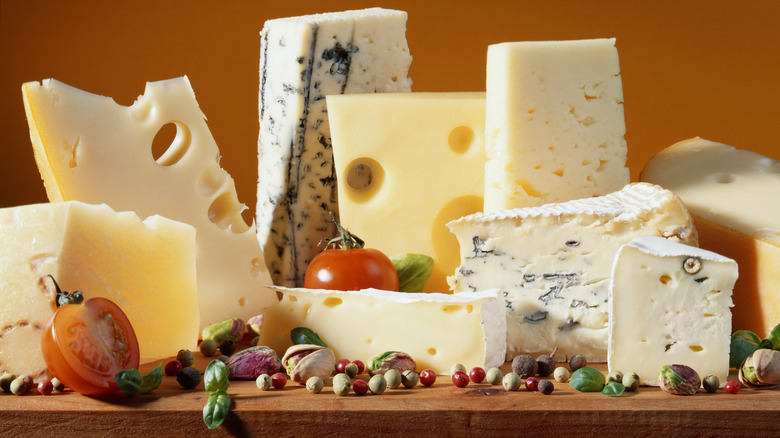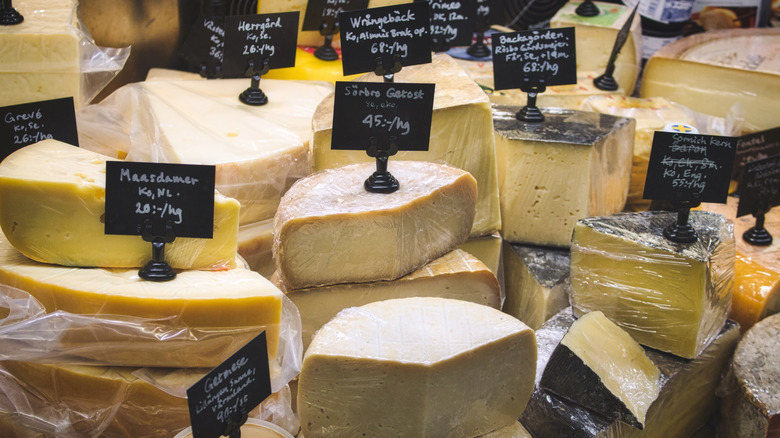The Red Flags To Avoid While Buying Cheese At The Grocery Store
Whether you're a newly initiated cheese fan or your cheesemonger knows you by name, there's always more to learn about shopping for cheese. One particularly big challenge is learning some of the warning signs that your wedge is past its prime. Yes, even though we'd like to think our beloved slice of aged Manchego and various types of mozzarella will last forever, that's sadly not the case.
To help understand the red flags in the cheese section, Food Republic asked cheesemonger Kathleen Serino, training and curriculum manager at New York City's Murray's Cheese, for advice. Serino spends her days teaching other experts about dairy products, as well as helping shoppers, making her well-equipped to navigate both sides of the counter. "All cheese has a shelf life," Serino said. "Unfortunately, the countdown clock starts the moment a wheel reaches perfect ripeness. Without the proper care and attention, that timer can speed up once the wheel is cut."
To get a better sense of whether the wedges at the store are reaching the tail end of that window, she considers three factors: exposure to light, the reliability of the refrigerator, and time on display. Too much light, which seeps through plastic film, and fluctuating temperatures make a big difference in speeding up that countdown clock and affecting both the appearance and flavor. Using your powers of observation, you can pick up on the indicators that a cheese is no longer at its best.
Warning signs at the cheese station
Harsh overhead lights have the power to penetrate and degrade your favorite dairy products. Prolonged exposure to fluorescent lights, combined with the slim protection of translucent plastic wrap, can be a recipe for discolored, bland, or flat-tasting cheese, explained Kathleen Serino. Sometimes, even the rinds look faded, which may foreshadow a similar decline in taste.
For shoppers, take the clear wrapping and brightly lit environment as warnings. If it's a familiar cheese, give it a thorough once-over, and sniff to ensure it lives up to your expectations. Also, listen for the quiet hum of the counter's climate control, which ensures the area stays cool and slightly humid. If you hear the clank or wheeze of a failing engine, try feeling inside the display case to confirm it's gently chilled.
This advice is particularly important for fans of products like Brie and Camembert. While not every cheese needs to be stored in the fridge, Serino explained that the softer and higher moisture the cheese, the cooler and more consistent the environment needs to be. If it's not being kept in those cave-like conditions, you'll notice signs of spoilage on the creamy surface. "Cheeses, especially blue cheeses that appear to be oozing, or cheese resting on surfaces with unexpected mold growth (remember what I said about broken-down coolers!) may not be in their best condition," Serino added.
Snagging the best of the grocery selection
Savvy shoppers can navigate around these red flags, and use them to inform their weekly cheese shopping. Start by making a mental note of the display during each visit, so you're better aware of the hunks languishing in the display case and the fresh-cut bites worth nabbing. You can also check the labels on each portion, making sure to skip items that have passed their expiration or sell-by date. "Cheese pieces still kicking around since your last visit are probably not going to taste the same as a piece you notice was cut just today," said Kathleen Serino.
Of course, when in doubt about your cheese, you can always turn to the experts working at your local store. To make absolutely sure you're getting a cheese you'll really love, don't hesitate to ask for a taste. As Serino explained: "It can be difficult to 'know' just by looking, and it is best to use all your senses to evaluate a sample."
Once you've made your choice, she added, don't be shy about asking for a freshly cut piece from a wheel behind the counter. After securing the savory treat, make sure to find and use your fridge's cheese drawer to preserve its taste.



